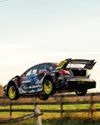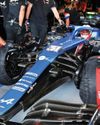
Motor racing purists, it seems, have lost the argument over whether single-seaters should carry head protection. Halos are now common on many high-level single-seaters, including Formula 1, F2, F3, and Super Formula. More importantly, since its introduction in 2018, the then much-maligned device has been credited with saving the lives of race drivers in F1, F2, and F3.
Now, two years on from the debut of the Halo, IndyCar will introduce its head protection system into competition for the first time. The Aeroscreen has been developed by IndyCar in collaboration with Red Bull Advanced Technologies, and although the construction of the structure is totally different to that of Formula 1, it conforms to all FIA standards and has been tested to Formula 1 standards at Cranfield in the UK.
Yet while IndyCar may be late to the head protection party, that does not mean that the concept started late. In fact, Red Bull Advanced Technologies contacted IndyCar about the idea, and IndyCar’s head of aero, Tino Belli, went to speak to Red Bull in 2016, just when the series was starting work on the Universal Aero Kit (UAK18) that replaced the manufacturer bodywork that had been developed by Honda and Chevrolet. That conversation didn’t immediately lead to a relationship being forged, but communications started again early in 2019, and design work started in April.
Screen grab
Red Bull had already designed a single curvature screen that it tested in Formula 1 as part of the FIA’s investigations into head protection, and IndyCar felt it was prudent to take its learning and turn it into a concept that was fit for the US series.
This story is from the February 2020 edition of Racecar Engineering.
Start your 7-day Magzter GOLD free trial to access thousands of curated premium stories, and 8,500+ magazines and newspapers.
Already a subscriber ? Sign In
This story is from the February 2020 edition of Racecar Engineering.
Start your 7-day Magzter GOLD free trial to access thousands of curated premium stories, and 8,500+ magazines and newspapers.
Already a subscriber? Sign In
Talk the torque
More thoughts on in-wheel motors and their effects on twisting force
Rolling about
An explanation of the limitations of a previous load transfer article, bringing jacking forces into the mix
F1 breaks schedule records
The FIA has confirmed no fewer than 23 races on the 2022 Formula 1 World Championship schedule, the highest number of grands prix ever to be held in a single season, and that has led to criticism from some teams that will be on the road for eight months.

Under pressure
Toyota may have finished first and second at Le Mans this year, but the effort required to overcome a fuel delivery problem and finish with both cars was Herculean
Physics at work
Dutch company, Intrax, offers Racecar Engineering an insight into the technologies it employs to optimise its suspension products
Williams' 2030 ambition
Williams Racing has committed to becoming climate positive by 2030 as part of an all-new sustainability strategy.
Diff'rent strokes
Racecar looks at the different types of mechanical differential, their benefits and limitations
Das Boot
A curious Twitter exchange fired up a unique, hydrogen-powered, cross-country project that will contest the Baja 1000 in November 2022

Air born
Every racecar engineer's dream is a blank sheet of paper design. When Hoonigan and Subaru approached Vermont Sportscars about building the next generation of Gymkhana racer, that's just what the company was given

Remote control
Called variously ‘virtual garages’, ‘mission control’ or ‘race support rooms’ is the future of race engineering sitting in the warm back at HQ?